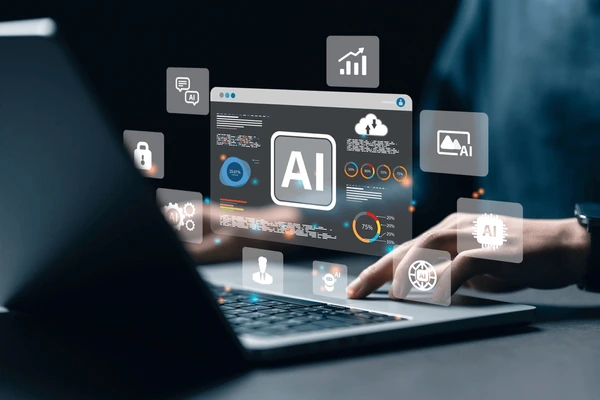Welcome to WordPress. This is your first post. Edit or delete it, then start writing!
In today’s digital age, having a website is no longer a luxury but a necessity for businesses of all sizes. A well-designed website can significantly impact a company’s success by enhancing its visibility, credibility, and customer engagement. Here are some key reasons why a website is crucial for any business:
1. Enhanced Online Presence
A website serves as the digital face of a company, accessible to anyone with an internet connection. It provides a platform for businesses to showcase their products or services, share their story, and reach a broader audience. In an era where consumers increasingly turn to the internet to find information, having a website ensures that your company can be found by potential customers.
2. Credibility and Professionalism
A professional website instills trust and confidence in your audience. It demonstrates that your company is established, serious, and capable of providing the services or products it advertises. Without a website, potential customers might question the legitimacy of your business, opting instead for competitors who have a stronger online presence.
3. Marketing and Advertising
Websites are powerful marketing tools. They can be optimized for search engines (SEO), helping your business appear higher in search results and attracting more visitors. Additionally, websites can host various forms of content, such as blogs, videos, and infographics, which can be shared across social media platforms, driving more traffic to your site. Online advertising campaigns, such as Google Ads, can also direct targeted traffic to your website, increasing the chances of converting visitors into customers.
4. Customer Engagement and Support
A website provides numerous ways to engage with customers and offer support. Features like contact forms, chatbots, and FAQ sections allow customers to ask questions, provide feedback, and resolve issues quickly. By offering valuable information and resources, a website can enhance the overall customer experience, leading to higher satisfaction and loyalty.
5. E-commerce Capabilities
For businesses selling products, an e-commerce website opens up new revenue streams. Online stores are convenient for customers, allowing them to browse and purchase products at any time. An e-commerce platform can expand your market reach, making it possible to sell to customers beyond your local area and even globally.
6. Analytics and Insights
Websites provide valuable data about customer behavior and preferences. Tools like Google Analytics can track how visitors interact with your site, which pages are most popular, and where traffic is coming from. This data can inform business decisions, helping you to refine your marketing strategies, improve user experience, and increase conversions.
7. Competitive Advantage
In many industries, not having a website puts you at a significant disadvantage compared to competitors who do. A website allows you to showcase what sets your business apart, from unique products and services to customer testimonials and case studies. By highlighting your strengths, you can attract customers who might otherwise choose a competitor.
8. Cost-Effective
Compared to traditional forms of advertising, maintaining a website is relatively inexpensive. Once set up, the ongoing costs of web hosting, domain registration, and occasional updates are minimal. Considering the potential return on investment, a website is one of the most cost-effective marketing tools available.
Conclusion
In conclusion, a website is a vital asset for any business in today’s interconnected world. It enhances visibility, credibility, and customer engagement, while also providing valuable insights and a competitive edge. Investing in a well-designed, functional website is not just an option but a critical component of a successful business strategy. As the digital landscape continues to evolve, the importance of a website will only grow, making it essential for companies to stay ahead and harness its full potential.
In today’s digital age, the importance of having a responsive website cannot be overstated. With an ever-increasing number of users accessing the internet through various devices, ensuring that your website provides an optimal viewing experience across all platforms is crucial. Here, we delve into the significance of responsiveness in web design and why it should be a top priority for businesses and web developers alike.
1. Enhanced User Experience
A responsive website automatically adjusts its layout and content to fit the screen size of the device being used. This means that whether a visitor is using a smartphone, tablet, laptop, or desktop computer, they will have a seamless and enjoyable browsing experience. Easy navigation, readable text, and properly displayed images contribute to a positive user experience, which can increase the time users spend on your site and reduce bounce rates.
2. Increased Mobile Traffic
With mobile devices accounting for more than half of global web traffic, having a mobile-friendly website is essential. A responsive design ensures that mobile users can access and navigate your site with ease, leading to higher engagement and potentially more conversions. Ignoring mobile responsiveness can result in lost opportunities and a significant portion of potential customers.
3. Improved SEO Rankings
Search engines like Google prioritize responsive websites in their search results. This is because a responsive design improves the user experience, which is a key factor in search engine optimization (SEO). By ensuring your website is mobile-friendly, you can improve your site’s visibility in search engine rankings, driving more organic traffic to your site and enhancing your online presence.
4. Cost-Effectiveness
Maintaining separate websites for desktop and mobile users can be costly and time-consuming. A responsive design eliminates the need for multiple versions of your site, as a single design adapts to all devices. This not only reduces development and maintenance costs but also ensures a consistent brand experience across different platforms.
5. Faster Loading Times
Responsive websites are optimized for speed, ensuring that pages load quickly on all devices. Fast loading times are crucial for retaining visitors, as users are likely to abandon a site that takes too long to load. By improving your site’s performance, you can enhance user satisfaction and increase the likelihood of repeat visits.
6. Future-Proofing Your Website
Technology and user behaviors are constantly evolving, with new devices and screen sizes being introduced regularly. A responsive design future-proofs your website by ensuring it can adapt to these changes without requiring a complete redesign. This flexibility allows your site to remain relevant and functional, regardless of how technology advances.
7. Enhanced Social Media Integration
Social media platforms are a significant source of traffic for many websites. When users share links to your site on social media, a responsive design ensures that the shared content looks good and functions well on all devices. This can lead to increased shares, likes, and engagement, further amplifying your online reach.
Conclusion
In a competitive online landscape, having a responsive website is no longer a luxury but a necessity. By prioritizing responsiveness, you can enhance the user experience, increase mobile traffic, improve SEO rankings, and reduce costs. Furthermore, a responsive design ensures your site is prepared for future technological advancements, keeping you ahead of the curve. Investing in a responsive website is an investment in your business’s success, helping you to attract and retain customers in an increasingly mobile world.
If you’re looking to transform your online presence with a responsive website and cutting-edge mobile app? Look no further than AJ IndoTech! Our expert team specializes in creating user-friendly, visually stunning websites and mobile apps that adapt seamlessly across all devices. Enhance your brand, boost your SEO rankings, and provide your users with an exceptional experience.
Contact Us today and take the first step towards a smarter, more responsive digital future!
Creating a compelling website is an art that blends aesthetics, functionality, and user experience. Whether you’re designing a personal blog, an e-commerce site, or a corporate page, these tips will help you create a site that stands out and keeps visitors engaged.
Understand Your Audience
Before you start designing, know who your audience is. Understand their needs, preferences, and behaviors. This insight will guide your design decisions and ensure your site resonates with your target audience.
Keep It Simple and Clean
A cluttered website can overwhelm visitors. Use white space effectively to make your content stand out. Stick to a minimalistic design with a clear visual hierarchy to guide users’ attention to the most important elements.
Ensure Easy Navigation
Your site’s navigation should be intuitive. Use a simple and consistent menu structure. Include a search bar for larger sites, and make sure all important pages are accessible within a few clicks. This enhances the user experience and helps visitors find what they need quickly.
Prioritize Mobile Responsiveness
With a significant number of users accessing websites via mobile devices, ensure your site is mobile-friendly. Use responsive design techniques to make sure your site looks great and functions well on all screen sizes.
Optimize for Speed
Website speed is crucial for user satisfaction and SEO. Compress images, use a content delivery network (CDN), and minimize the use of heavy scripts. Regularly test your site’s speed and make necessary adjustments.
Focus on Readability
Choose fonts that are easy to read and maintain a good contrast between text and background. Break up text into manageable chunks with headings, subheadings, bullet points, and images to make your content more digestible.
Use High-Quality Visuals
High-quality images, videos, and graphics can make your site more engaging. Use professional visuals that align with your brand. Optimize them for fast loading to enhance the user experience without compromising speed.
Incorporate Strong Calls to Action (CTAs)
Effective CTAs guide users towards desired actions, whether it’s signing up for a newsletter, making a purchase, or contacting you. Make your CTAs stand out with contrasting colors and compelling text.
Ensure Accessibility
Design your website to be accessible to everyone, including people with disabilities. Use alt text for images, provide transcripts for videos, and ensure your site is navigable using a keyboard. Follow the Web Content Accessibility Guidelines (WCAG) for best practices.
Test, Analyze, and Improve
Regularly test your website for functionality, usability, and performance. Use tools like Google Analytics to track user behavior and identify areas for improvement. A/B testing can help you make data-driven decisions about design changes.
Conclusion
A well-designed website is a powerful tool for engaging users and achieving your goals. By understanding your audience, keeping the design simple, ensuring easy navigation, prioritizing mobile responsiveness, optimizing for speed, focusing on readability, using high-quality visuals, incorporating strong CTAs, ensuring accessibility, and continuously testing and improving, you can create a website that not only looks great but also provides an exceptional user experience.
Remember, good design is an ongoing process. Stay updated with the latest trends and continuously seek feedback to keep your website fresh and effective.
Are you ready to implement these tips and elevate your website to the next level? At AJ Indotech, we specialize in creating stunning, user-friendly websites and mobile apps tailored to your needs. Whether you’re starting from scratch or looking to revamp your existing site, our expert team is here to help.
Why Choose AJ Indotech?
- Customized Solutions: We understand your unique business requirements and craft bespoke designs that reflect your brand identity.
- Mobile-First Approach: Our designs are fully responsive, ensuring a seamless experience across all devices.
- Speed Optimization: We implement the best practices to keep your website fast and efficient.
- Accessibility Compliance: We ensure your site is accessible to everyone, meeting all WCAG standards.
- Ongoing Support: From initial design to ongoing maintenance, we provide comprehensive support to keep your site running smoothly.
Ready to transform your digital presence? Visit AJ Indotech and let’s start building your dream website today!







